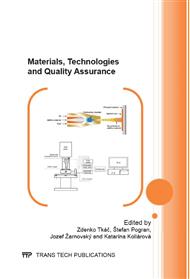[1]
P. Valášek, M. Müller, Influence of bonded abrasive particles size on wear of polymeric particle composites based on waste, Manufacturing Technology. 12(13) (2012) 268-272.
DOI: 10.21062/ujep/x.2012/a/1213-2489/mt/12/2/268
Google Scholar
[2]
P. Valášek, M. Müller, A. Proshlyakov, Effect of sedimentation on the final hardness of polymeric particle composites, Research in Agricultural Engineering. 58(3) (2012) 92-98.
DOI: 10.17221/5/2011-rae
Google Scholar
[3]
E. Ragan et al., Vstrekovanie a spracovanie plastických hmôt, 1st ed., FVT TU, Prešov, 2008, 549 pp.
Google Scholar
[4]
B.A. Davis et al., Compression molding, Hanser Gardner Publications, Munich, 2003, 196 pp.
Google Scholar
[5]
Compression molding. Information on http://www.ticona.com/home/tech/processing/compression_molding.htm
Google Scholar
[6]
T. Duraník, J. Ružbarský, Effect of material dosage on closing of the compression mold, In: Quality and Reliability of Technical Systems, SUA in Nitra, Nitra, 2012, pp.118-121.
Google Scholar
[7]
V. Kulik, J. Paško, Výroba plastových profilov technológiou vytlačovania do formy, Plastics Production. 7(1) (2012) 52-53.
Google Scholar
[8]
A.C. Metaxas, R.J. Meredith, Industrial Microwave Heating (IEE Power Engineering Series), Institution of Engineering and Technology (1983)
Google Scholar
[9]
T. Duraník, M. Stopper, J. Ružbarský, Influence on the productivity of modern thermoset preheating in compression molding technology, Advanced Materials Research. 717 (2013) 74-78.
DOI: 10.4028/www.scientific.net/amr.717.74
Google Scholar
[10]
T. Duraník, M. Stopper, J. Ružbarský, Applying value stream mapping to identify hidden reserves and avoid bottlenecks, In: Annals of DAAAM for 2011 & Proceedings of the 22nd International DAAAM Symposium on 'Intelligent Manufacturing & Automation: Power of Knowledge and Creativity', DAAAM International, Vienna, 2011, pp.969-970.
DOI: 10.2507/22nd.daaam.proceedings.473
Google Scholar
[11]
E. Ragan, J. Dobránsky, P. Baron, T. Olejár, Materijal matrica za tlačno lijevanje, Metalurgija. 51(1) (2012) 117-120.
Google Scholar
[12]
E. Ragan, P. Baron, J. Dobránsky, Sucking machinery of transport for dosing granulations of plastics at injection molding, Advanced Materials Research. 383-390 (2012) 2813-2818.
DOI: 10.4028/www.scientific.net/amr.383-390.2813
Google Scholar
[13]
L. Běhálek, J. Dobránsky, Conformal cooling of the injection moulds, Applied Mechanics and Materials. 308 (2013) 127-132.
DOI: 10.4028/www.scientific.net/amm.308.127
Google Scholar
[14]
Slovak Institute for Standardization. Information on http://www.sutn.sk/eshop/public/standard_detail.aspx?id=96775
Google Scholar
[15]
Used technical standard NF XP D 12-207
Google Scholar
[16]
Used technical standard DIN 19516
Google Scholar
[17]
P. Valášek, M. Müller, Statistical comparison of the hardness of polymeric particle composites with a filler on the basis of waste from mechanical surface treatment, caused by gravitation induced sedimentation, In: Trends in Agricultural Engineering 2010, Czech University of Life Sciences Prague, Prague, 2010, pp.623-626.
Google Scholar
[18]
Š. Gašpár, P. Paško, J. Malík, A. Panda, J. Jurko, J. Maščenik, Dependence of pressure die casting quality on die casting plunger velocity inside a filling chamber of a pressure die casting machine, Advanced Science Letters. 14(1) (2012) 499-502.
DOI: 10.1166/asl.2012.3989
Google Scholar


